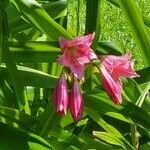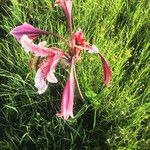Perennial herb, up to 0.9 m high. Leaves bluish grey-green, folded upwards, > 50 mm broad at middle; new leaves many. Flowers: perianth tube long, > 70 mm long; perianth segments ± as long as or shorter than tube, forming a narrow trumpet-shape; anthers grey or brown; old flowers drying pink or red; perianth white with a dark red keel; Sep.-Nov. Fruit an indehiscent, subglobose capsule, not beaked, tipped with a ring.
Bulbs 8–10 × 6–8 cm. Leaves 5–8 dm × 3–5 cm; blade lorate. Scape 4–7.5 dm. Umbels 8–13-flowered. Flowers: perianth pink to red, funnelform, tube narrow, 5–10 cm, limb lobes lanceolate-linear, lanceolate-elliptic, or lanceolate-ovate, 6–11 × 1–1.7 cm; pedicel (2–)4–6 cm. Capsules not seen at maturity, beak very short to absent.
A herb which has a bulb and is dormant for part of the year. It grows 1 m tall. The leaves are flat and strap shaped. They are 60-90 cm long. There are teeth along the edge. The flowers are funnel shaped and have purple or white streaked lobes. The tube of the flower is green. The flower can be 12 cm long and is curved.
Perennial herb, up to 0.9 m high. Leaves over 50 mm broad at middle. Perianth segments forming a narrow trumpet shape. Anthers grey or brown. Old flowers drying pink or red. Fruit not beaked. New leaves many. Flowers white with a dark red keel.


